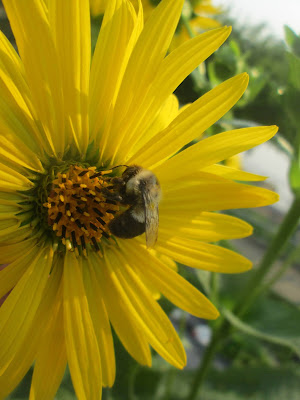Silphium perfoliatum, our native cup plant, is no shrinking violet. Native to fields, prairies, roadsides, and ditches, this enthusiastic yellow composite can reach heights of ten feet, making it one of Ohio's most striking wildflowers. As tough as it is beautiful, the specimen in my old yard survived at least two years heeled in in a pot much too small for its root system, the gnarled result having to be cut out of its broken container when I finally got around to planting it (hence my Wildlife Gardeners title of "Official Silphium Abuser"). The clump below survived by pushing its way through the solarization plastic on the slope intended to house Phase Two of the Fort Street Pollinator Habitat. (In our volunteers' defense, we got the site in November, when the silphium had already collapsed into a mass of dried stems, so we did not know what a treasure we had.)
Goldfinches seem as fond of cup plant seeds as they are those of its cousin, the annual sunflower, and this beauty comes back on its own every year. It is a favorite pollen source for bees,
and some species of leafcutter bees nest in the hollow stems that remain at the end of the growing season. It also serves as a larval host for some moth species.
Besides, cup plant is attractive in all stages of growth. The leaves are lush, the blossoms are undeniably impressive, and the buds and opening blooms are just plain fun.
Yes, we're going to have to keep an eye on our golden Silphiums to be sure they don't take up too much room, but we suspect the Joe-Pye weed going in this fall will be able to hold its own.







No comments:
Post a Comment